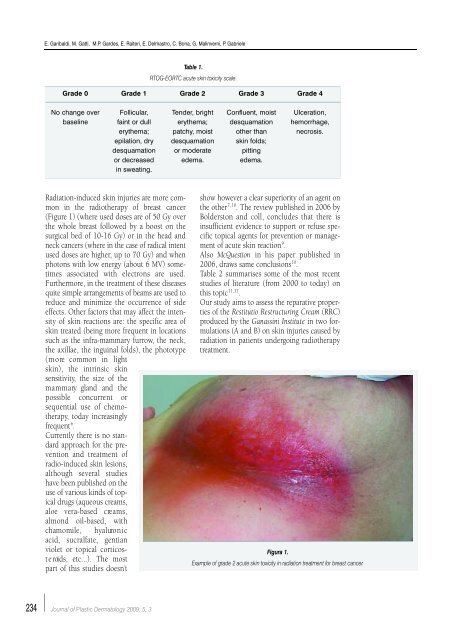Vol. 5, n. 3, September-December 2009 - Salute per tutti
Vol. 5, n. 3, September-December 2009 - Salute per tutti
Vol. 5, n. 3, September-December 2009 - Salute per tutti
Create successful ePaper yourself
Turn your PDF publications into a flip-book with our unique Google optimized e-Paper software.
E. Garibaldi, M. Gatti, M.P. Gardes, E. Raiteri, E. Delmastro, C. Bona, G. Malinverni, P. Gabriele<br />
Table 1.<br />
RT O G - E O RTC acute skin toxicity scale.<br />
Grade 0<br />
Grade 1<br />
Grade 2<br />
Grade 3<br />
Grade 4<br />
No change over<br />
baseline<br />
Follicular,<br />
faint or dull<br />
erythema;<br />
epilation, dry<br />
desquamation<br />
or decreased<br />
in sweating.<br />
Tender, bright<br />
erythema;<br />
patchy, moist<br />
desquamation<br />
or moderate<br />
edema.<br />
Confluent, moist<br />
desquamation<br />
other than<br />
skin folds;<br />
pitting<br />
edema.<br />
Ulceration,<br />
hemorrhage,<br />
necrosis.<br />
Radiation-induced skin injuries are more common<br />
in the radiotherapy of breast cancer<br />
(Figure 1) (where used doses are of 50 Gy over<br />
the whole breast followed by a boost on the<br />
surgical bed of 10-16 Gy) or in the head and<br />
neck cancers (where in the case of radical intent<br />
used doses are higher, up to 70 Gy) and when<br />
photons with low energy (about 6 MV) sometimes<br />
associated with electrons are used.<br />
Furthermore, in the treatment of these diseases<br />
quite simple arrangements of beams are used to<br />
reduce and minimize the occurrence of side<br />
effects. Other factors that may affect the intensity<br />
of skin reactions are: the specific area of<br />
skin treated (being more frequent in locations<br />
such as the infra-mammary furrow, the neck,<br />
the axillae, the inguinal folds), the phototype<br />
( m o re common in light<br />
skin), the intrinsic skin<br />
sensitivity, the size of the<br />
m a m m a ry gland and t h e<br />
possible concurrent or<br />
sequential use of chemotherapy,<br />
today increasingly<br />
frequent 6 .<br />
Currently there is no standard<br />
approach for the prevention<br />
and treatment of<br />
radio-induced skin lesions,<br />
although several studies<br />
have been published on the<br />
use of various kinds of topical<br />
drugs (aqueous creams,<br />
aloe vera-based cre a m s ,<br />
almond oil-based, with<br />
chamomile, hyaluro n i c<br />
acid, sucralfate, gentian<br />
violet or topical corticost<br />
e roids, etc...). The most<br />
part of this studies doesn’t<br />
show however a clear su<strong>per</strong>iority of an agent on<br />
the other 7, 10 . The review published in 2006 by<br />
Bolderston and coll, concludes that there is<br />
insufficient evidence to support or refuse specific<br />
topical agents for prevention or management<br />
of acute skin reaction 9 .<br />
Also McQuestion in his pa<strong>per</strong> published in<br />
2006, draws same conclusions 10 .<br />
Table 2 summarises some of the most recent<br />
studies of literature (from 2000 to today) on<br />
this topic 11,17 .<br />
Our study aims to assess the reparative pro<strong>per</strong>ties<br />
of the Restitutio Restructuring Cream (RRC)<br />
produced by the Ganassini Institute in two formulations<br />
(A and B) on skin injuries caused by<br />
radiation in patients undergoing radiotherapy<br />
treatment.<br />
Figura 1.<br />
Example of grade 2 acute skin toxicity in radiation treatment for breast cancer.<br />
234<br />
Journal of Plastic Dermatology <strong>2009</strong>; 5, 3

















